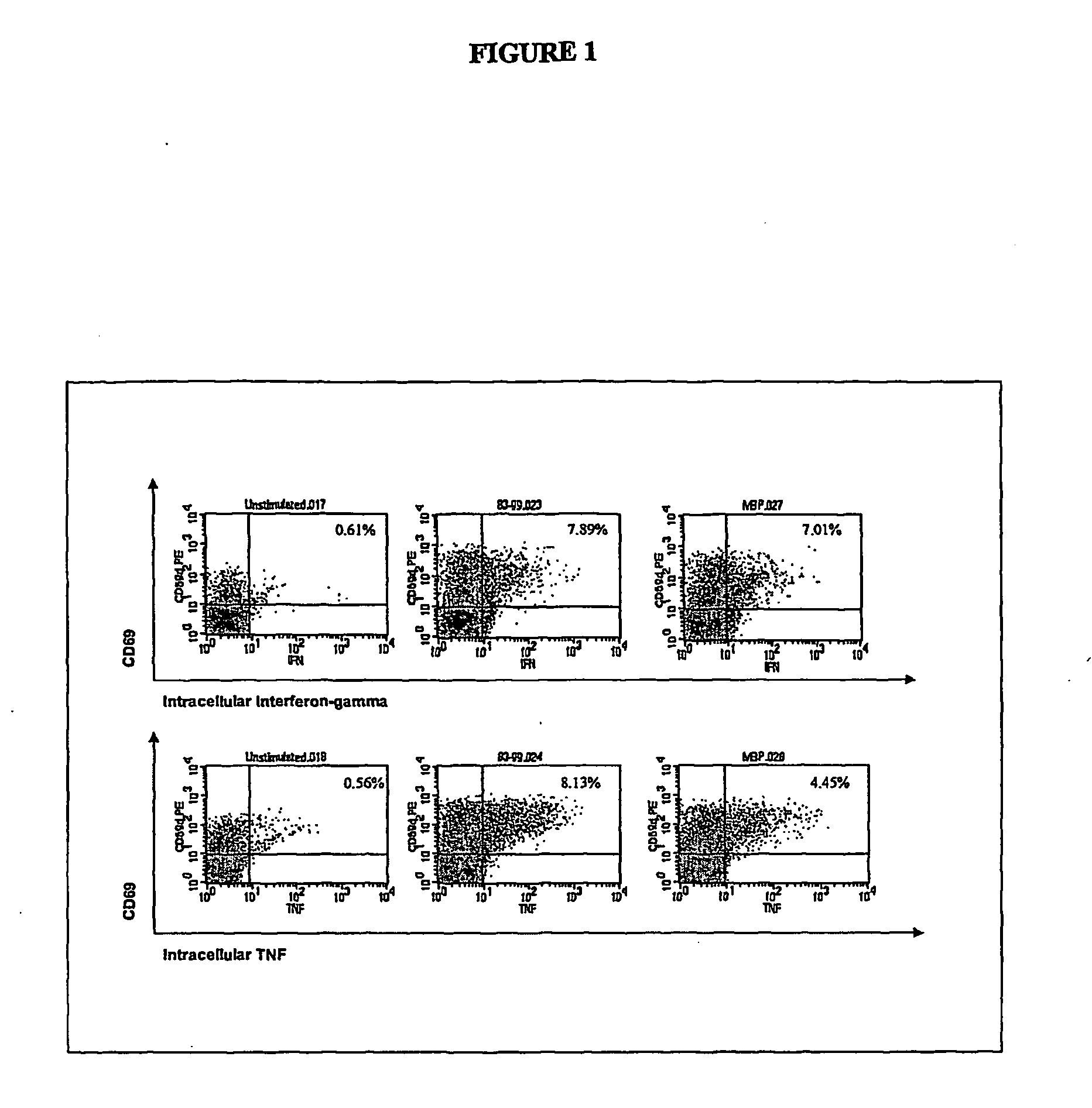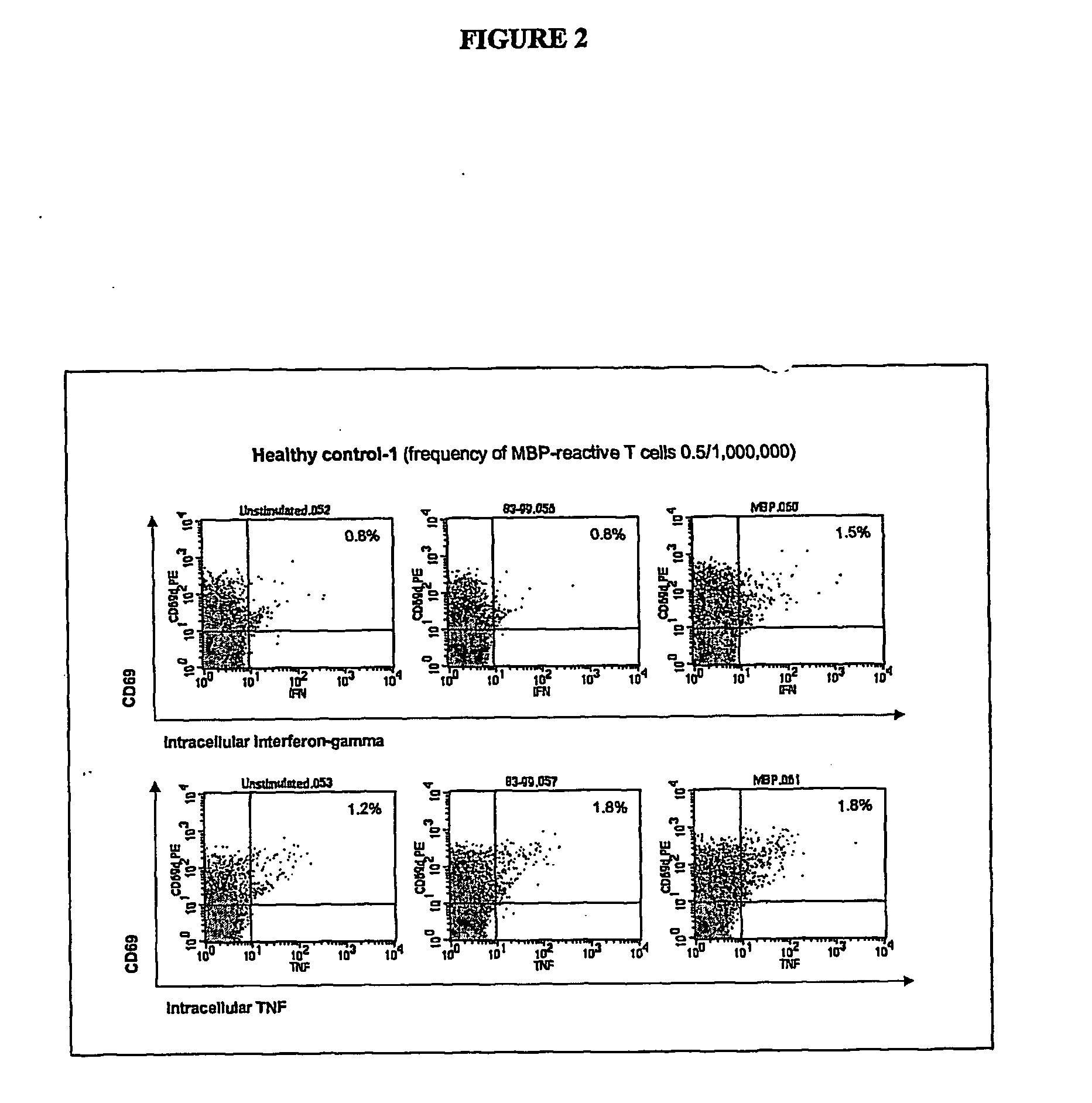Isolation and identification of t cells
a technology of t cells and antibodies, applied in the field of diagnosis and treatment of autoimmune diseases, can solve the problems of autoreactive t cells, present a potential risk in the induction of autoimmune pathologies, and the antigen recognition of autoreactivity by itself is not sufficient to mediate the autodestructive process
- Summary
- Abstract
- Description
- Claims
- Application Information
AI Technical Summary
Benefits of technology
Problems solved by technology
Method used
Image
Examples
example 1
Isolation of Myelin-Reactive T Cells for T Cell Vaccination
1. Preparation of PBMC and the Primary Stimulation
[0092] Fresh blood specimens from MS patients and control patients were processed within 2 hours of collection. Alternatively, mononuclear cells may be obtained from the cerebrospinal fluid (CSFMCs) of MS patients. Peripheral blood mononuclear cells (PBMCs) were isolated from the whole blood by standard Ficoll gradient separation method. Specifically, heparinized blood was diluted with Hanks balanced salt solution (HBSS) (1:1 blood / HBSS) and then slowly laid over the Ficoll-hypaque solution in a centrifuge tube and centrifuged for 20 minutes at 1800 rpm, 18° C. to 25° C., with no brake. PBMCs were then washed by adding excess HBSS and centrifuged at 1700 rpm for 10 minutes at 18° C. to 25° C. Purified PBMCs were washed three times in RPMI 1640 medium by centrifugation and subsequently resuspended in AIM V medium (Gibco, Grand Island, N.Y.). Cell number was counted and cell...
example 2
Diagnosis of MS
[0096] Two to 100 ml of blood are collected from the patient and one or more synthetic peptides are added directly to the whole blood to prime, or stimulate, the T lymphocytes. The peptides correspond to the known immunodominant regions of three myelin proteins, myelin basic protein (MBP), proteolipid protein (PLP), and myelin oligodendrocyte glycoprotein (MOG). The blood is incubated with the peptides for 1 to 7 days to activate the myelin-specific T cells. At the end of this antigen-priming period, the cells are re-challenged with antigens in a short re-stimulation assay.
[0097] Myelin peptide-activated T cells are detected by permeabilizing the cell membrane with a detergent solution, washing the cells, then incubating with one or more staining antibodies to detect CD4 or CD69 molecules on the cell surface or IFNγ or TNFα intracellularly. The staining antibodies are conjugated to different fluorochromes so that they fluoresce at different wavelengths when excited ...
example 3
Diagnosis of MS Using Antibody-Conjugated Liposomes
[0098] Whole blood is obtained from a patient and stimulated with one or more synthetic peptides as described in Example 2. The blood is incubated with the peptides for 3 to 16 hours to activate the myelin-specific T cells. At the end of this antigen-priming period, the cells may be re-challenged with antigens in a short re-stimulation assay prior to staining with magnetofluorescent liposomes conjugated to antibodies against IFNγ, TNFα, or a combination thereof. The cells are also stained with an antibody to CD4 and / or CD69. The stained myelin-reactive T cells are detected as described in Example 2.
PUM
| Property | Measurement | Unit |
|---|---|---|
| Time | aaaaa | aaaaa |
| Time | aaaaa | aaaaa |
| Time | aaaaa | aaaaa |
Abstract
Description
Claims
Application Information
 Login to View More
Login to View More - R&D
- Intellectual Property
- Life Sciences
- Materials
- Tech Scout
- Unparalleled Data Quality
- Higher Quality Content
- 60% Fewer Hallucinations
Browse by: Latest US Patents, China's latest patents, Technical Efficacy Thesaurus, Application Domain, Technology Topic, Popular Technical Reports.
© 2025 PatSnap. All rights reserved.Legal|Privacy policy|Modern Slavery Act Transparency Statement|Sitemap|About US| Contact US: help@patsnap.com


